Any garden or outdoor area would benefit greatly from the presence of oak trees. They are renowned for their majesty, resilience, and strength. They are, nonetheless, vulnerable to illnesses like any other tree, which might seriously jeopardize their long-term health. This article will discuss some of the most prevalent illnesses that afflict oak trees as well as the best ways to cure them. We will assist you in recognizing the signs of several diseases, such as anthracnose, leaf blister, and oak wilt, and offer you with the knowledge you need to safeguard your oak tree. Whether you are a homeowner, a gardener, or a lover of the outdoors, this article will offer you helpful advice on how to preserve the health of your oak tree and ensure its continued success for many years.
Overview of prevalent diseases that impact oak trees
Magnificent and respected for their power, beauty, and lifespan are oak trees. They are not, however, immune to illnesses that, if ignored, may have a disastrous effect. It is crucial for responsible tree owners to be aware of the numerous diseases that may affect oak trees and to take preventative action to keep them safe.
Oak Wilt is one of the most common diseases that damage oak trees. This fatal fungal infection may cause the whole tree to droop and die, and it spreads quickly. White oaks are more resistant to oak wilt, whereas red oaks are more vulnerable to it. It is vital to comprehend the indications of Oak Wilt and use suitable remedial measures to avert its catastrophic consequences.
Bacterial Leaf Scorch is another prevalent disease that may harm oak trees. The leaves will get brown and scorched, and finally they will drop early due to this bacterial illness. Bacterial Leaf Scorch may impair the tree’s general health and increase its vulnerability to other illnesses or pests. Improving treatment outcomes and achieving a prompt diagnosis are crucial for reducing the severity of this illness.
Another disease that may afflict oak trees is anthracnose. This fungal infection appears on leaves, stems, and acorns as dark, sunken sores. Defoliation, slowed development, and even branch dieback may result from anthracnose. To avoid serious damage and prolong the life of the oak tree, regular inspections and timely treatment are essential.
It is important to remember that early detection and prevention are essential in the fight against chronic illnesses. Maintaining a regular check on the general health of your oak tree, adhering to good hygiene practices, and putting suitable treatment plans in place can help protect your treasured oak tree from these prevalent illnesses.
Table of Contents
We will go into more detail about each of these illnesses in the parts that follow, going over their causes, signs, and efficient treatments. With this information at your disposal, you will be able to take the appropriate actions to ensure the life and aesthetic appeal of your oak tree.
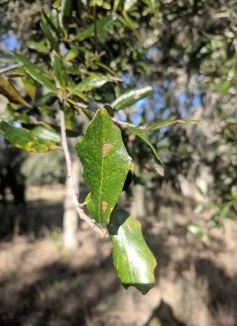
Recognizing oak tree disease indicators and symptoms
Knowing the warning signs and symptoms of diseases that affect oak trees is essential to properly safeguarding your stately oak tree. Despite their reputation for sturdiness and strength, oak trees are vulnerable to a number of diseases that, if ignored, may weaken and even kill them.
A fungus known as Ceratocystis fagacearum is the cause of oak wilt, a widespread disease of oak trees. Through the tree’s vascular system, this illness may spread swiftly, obstructing the passage of nutrients and water. Wilting and browning of the leaves, which begin at the top of the tree and go downhill, are symptoms of oak wilt. Fungal mats, which show up on the bark of infected trees as black streaks or spore-producing structures, are another sign of infection.
The fungal pathogen Taphrina caerulescens is also a common cause of oak leaf blister. This disease usually affects young leaves, resulting in top surface bulges or raised blisters. The leaves may ultimately curl or become deformed as a result of these blisters becoming brown. Although oak leaf blister seldom results in significant harm to the tree’s general health, recurrent infections may eventually deteriorate the tree.
Another fungus that often infects oak trees is powdery mildew. It shows up as a powdery, white or grayish covering on the buds, stems, and leaves. In extreme instances, premature leaf drop may occur, and infected leaves may become deformed or stunted. Powdery mildew normally does not pose a threat to life, but it may weaken the tree and increase its susceptibility to other illnesses and environmental stresses.
Oak trees are susceptible not only to fungal diseases but also to bacterial infections like bacterial leaf scorch. The illness results in blackened or burned margins on the leaves that eventually go within. Additionally, early leaf loss and branch dieback are possible symptoms of infected trees. Insects that feed on xylem, such as leafhoppers, are commonly the carriers of bacterial leaf scorch.
It is essential to regularly check your oak tree for these indications and symptoms in order to identify illnesses early and apply the proper care. Speak with a qualified arborist or tree care expert if you see any irregularities or think your oak tree could be sick. In order to save and maintain your prized oak tree, they are able to precisely identify the issue and suggest the best course of action.
Prevention is the Greatest Medication
As is true with most issues, correct care is one of the best protection in opposition to any sickness or setback. Oak bushes, like all vegetation, profit from ample water, daylight and good soil circumstances. To maintain bushes wholesome and stress-free, guarantee the next:
- Apply a few 3-inch deep layer of natural mulch out to the dripline; don’t pile mulch in opposition to the trunk. Preserve it at the least 6 inches away from the bottom of the tree.
- Don’t apply weed killers close to the tree.
- Use gradual-launch fertilizers in early April if essential.
- Water bushes throughout droughts, offering about 1 inch of water weekly.
- Defend bushes and root methods from injury. Wounds from development, lawnmowers, weed-whackers, and even pruning may be the impetus for illness.
- Promptly take away and get rid of contaminated bushes and grind stumps to stop illness unfold.
- Plant illness-resistant oak bushes. However first, examine the pH of your soil. Oak bushes like a decrease pH.
How to Establish and Treat Oak Tree Ailments
In accordance to Encyclopedia Britannica, oaks are available in three teams: white, pink, and black. Widespread species in North America embrace:
- Pin oak (Quercus palustris)
- Northern pink oak (Q. rubra)
- White oak (Q. alba)
- Bur oak (Q. macrocarpa)
With a life span of over 200 years, oaks are actually mighty. They stay in almost each U.S. state. There are over 500 sorts (over 90 in the USA), however illness, sickness, and damage can have an effect on all of them. Listed below are some ailments that may have an effect on your oak.
Anthracnose
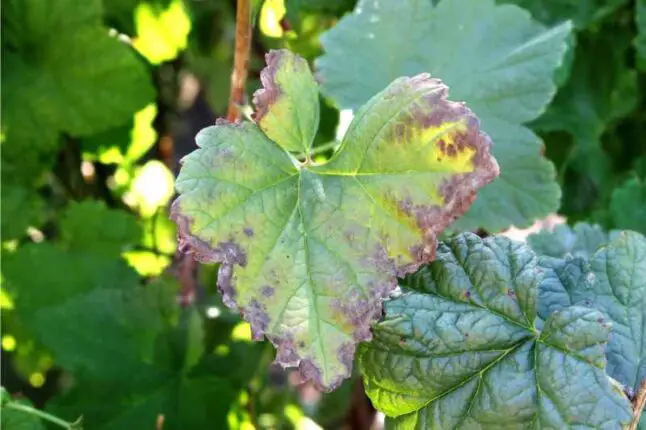

Bushes might lose their leaves in extreme anthracnose, however they usually refoliate earlier than the summer season is over. One of these oak tree fungus can survive winter in buds, twigs, fruit, fallen leaves, or petioles (the place the leaf’s stem joins it to a department).
Signs: Small, brown spots kind on the brand new leaf floor and on new twigs. Lifeless areas seem alongside the leaf veins, totally on decrease branches. Leaves can cup or grow to be distorted and should ultimately tackle a brown, papery look.
Causes: Cool, moist climate helps incubate and simply unfold this fungus (Apiognomonia quercina).
Season: Anthracnose takes maintain through the spring and funky summers.
Threat Stage: Anthracnose is a standard white oak tree illness, as this species is extra vulnerable to anthracnose than different oak species. This illness can have an effect on all oaks in addition to many different vegetation and greens. Nevertheless, it’s uncommon for bushes to die from this an infection.
Remedy: On the whole, one of the best therapy consists of pruning lifeless twigs and branches throughout dormancy; additionally prune to improve air and light-weight circulation. Rake leaves after they fall and destroy them. For severely broken bushes, apply an applicable fungicide to shield new development.
Armillaria Root Rot, or Honey Fungus
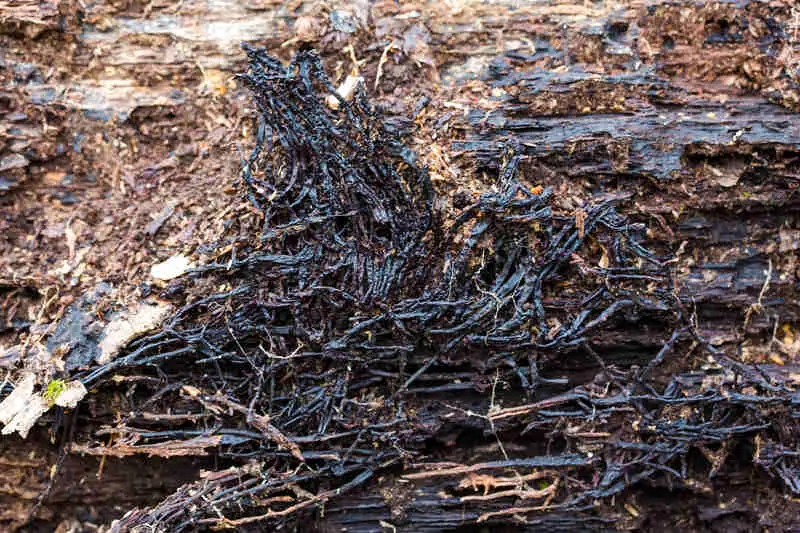

Stress imparts an elevated susceptibility to armillaria root rot, which causes a gradual tree decline. You might even see lifeless limbs on the prime of the oak. The roots and decrease trunk decay, main to the tree falling over in storms, together with hurricanes.
Signs: At first, white mats of fungus peel or shave off the bark on the decrease parts of bushes. Rhizomorphs, which appear like darkish shoestrings, then seem. They will develop a couple of inches or a number of toes lengthy. The rhizomorphs create huge underground networks, increasing 2 to 4 toes per 12 months, that may have an effect on close by vegetation.
Lastly, honey-coloured mushrooms kind on the base of the tree within the late summer season or autumn. These growths seem in massive teams. Mushrooms also can seem all through the yard, an indication of illness unfold.
Causes: Moist climate, tree wounds (comparable to these from lawnmowers, weed trimmers, and development), and improper drainage improve the probability of armillaria root rot from this fungus (Armillaria mellea).
Season: Injury seems in late summer season and autumn.
Threat Stage: All kinds of oak are vulnerable.
Remedy: This root rot leads to a gradual decline; diseased bushes can fall. Take away contaminated bushes and their whole root system. Have close by vegetation checked for this an infection.
Bacterial Leaf Scorch
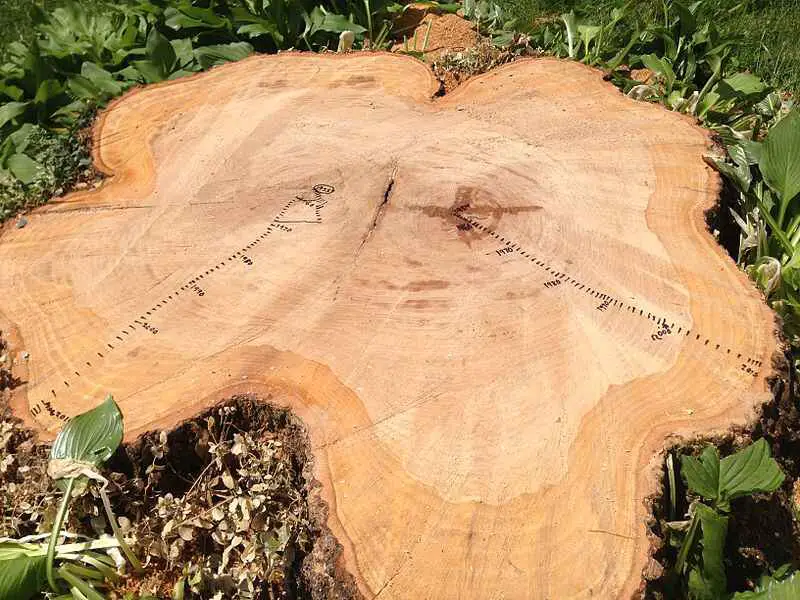

In bacterial leaf scorch, the leaves resprout 12 months to 12 months, however the illness reappears. It may be discovered in several spots all through the oak, and the signs might differ within the numerous kinds of oak. Laboratory analysis is the one technique of confirming the illness.
Signs: The sides of leaves flip brown, starting on the interior, decrease parts of a pin oak. A reddish-coloured band generally develops between the brown and inexperienced on the leaf. In different pink oaks, the ideas brown, a course of that progresses towards the stem. Branches start to die randomly.
Causes: Leafhoppers and spittlebugs carry the Xylella fastidiosa bacterium, which infects the tree and disrupts water motion all through it.
Season: Signs stay undetected for years earlier than they seem in mid to late summer season, sometimes after a summer season drought.
Threat Stage: Bacterial leaf scorch is commonest in pin, pink, white, and bur oak varieties.
Remedy: No therapy exists as a result of the bugs inflicting bacterial leaf scorch are tough to management. Annual oxytetracycline injections by knowledgeable can assist, however not treatment, the illness. Trimming and destroying affected branches will help. Finally, often inside 5 to 10 years after preliminary signs seem, bushes want to be eliminated.
Bacterial Wetwood, aka Slime Flux
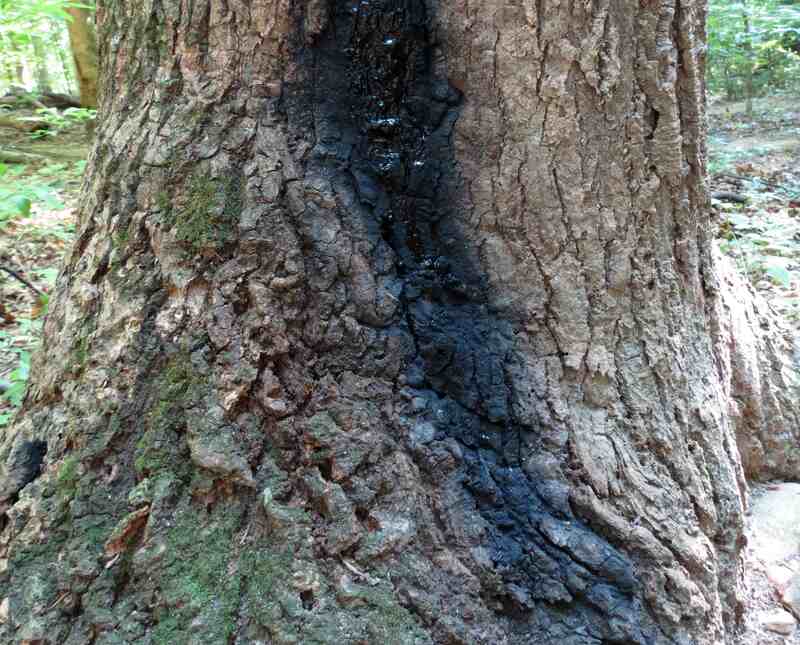

In bacterial wetwood, organisms infect the heartwood (middle) of the tree and begin a construct-up of stress that forces ooze, referred to as “slime flux,” out cracks and wounds. Younger bushes might wilt, whereas the vigor of older bushes declines or department dieback happens within the higher crown.
Signs: Darkish streaks of slimy sap ooze from the bark and sometimes carry an disagreeable odor. These streaks might lighten and grow to be gentle brown or grey. The liquid might kill vegetation beneath the tree.
Causes: Many alternative micro organism, together with species of Enterobacter, Klebsiella, and Pseudomonas, trigger this illness after they enter the tree’s heartwood via wounded, soaked bark.
Season: Slime flux begins in late spring and lasts all through the summer season.
Threat Stage: All oaks can develop this illness, however bacterial wetwood is an particularly widespread pin oak illness. Wetwood might shield in opposition to wooden-rotting fungi.
Remedy: The final well being of a tree is unaffected by wetwood. Nevertheless, as soon as a tree has this illness, solely ameliorative measures work. Take care of sick bushes as regular and decrease stress as a lot as attainable. Don’t use drain tubes as a result of they trigger further wounds that might lead to further oozing.
Chlorosis
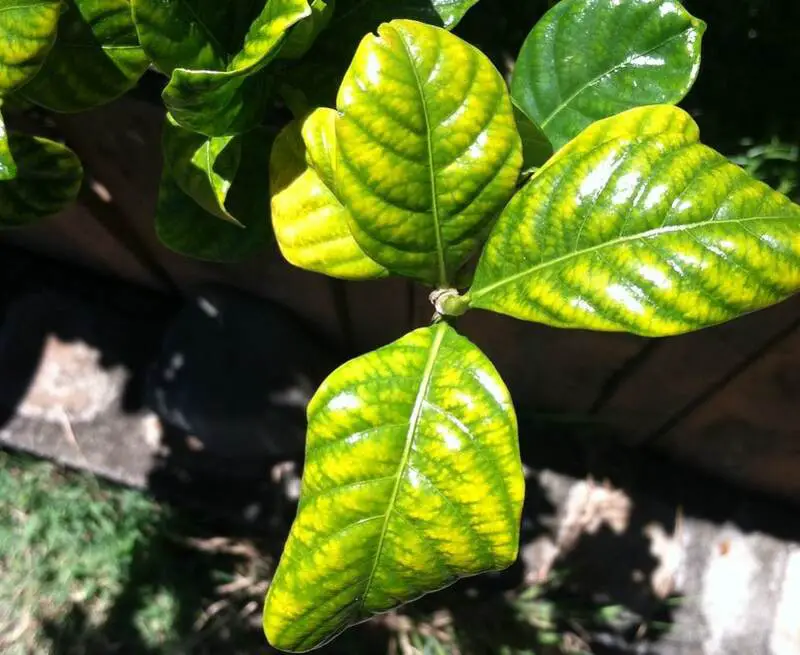

Even oak bushes can develop iron-deficiency anemia. Chlorosis causes the leaves of the tree to yellow or flip vivid inexperienced. It usually happens the place the topsoil has been disturbed, comparable to new subdivisions.
Signs: Yellowing of the leaves happens. Tree limbs might start to die after an oak has had the illness for a number of years.
Causes: When iron deficiency happens in oak bushes, leaves can not make chlorophyll, ensuing of their yellow look. An alkaline soil with a pH of larger than 7.5 may cause chlorosis in pin oaks. Bur oaks like a pH of 5.5 or below.
Season: Chlorosis can happen any time after leaves have sprouted.
Threat Stage: Extreme chlorosis that continues to be untreated defoliates and weakens oaks, which can ultimately die. Vulnerable species are pin oak and white oak.
Remedy: The perfect therapy is prevention; don’t plant oaks in excessive-pH areas. To decrease the soil pH round grown bushes, apply iron sulfate or sulfur.
Iron chelates enhance the yellowing however just for a short while; it’s costly, too. Iron may be sprayed on the foliage or injected into the tree by an arborist however lasts solely a 12 months and doesn’t deal with the basis of the issue.
Ganoderma Root Rot
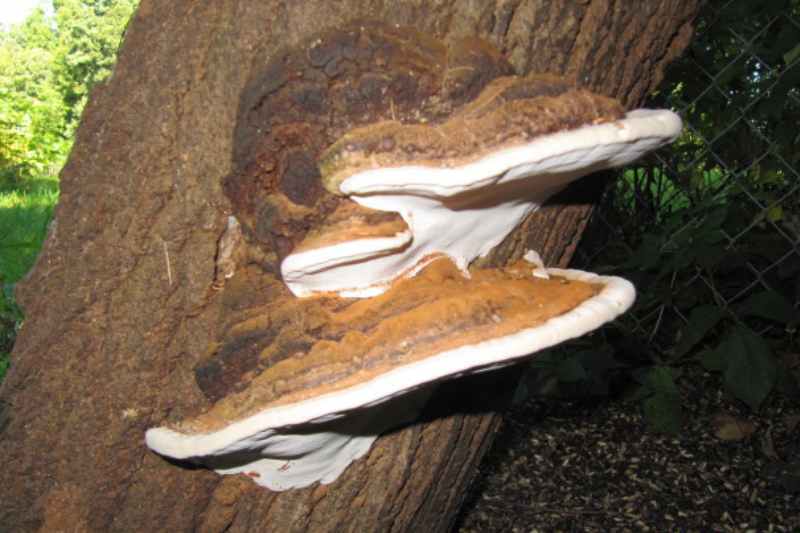

Drought and damage improve the danger of ganoderma root rot. Tree development slows, and dying branches produce smaller, yellowed leaves.
Signs: Shelf-like mushrooms (conks) kind on the wooden close to the soil line; they often seem brown to reddish and might develop up to 30 inches huge, relying on the species.
Causes: The fungi species Ganoderma zonatum, G. lucidum, and G. applanatum trigger this root rot. Fungal spores unfold via the wind and infect the tree, main to wooden decay.
Season: Throughout humid durations of the summer season, the conks launch spores, which infect open wounds on vulnerable bushes. Conks could also be seen every summer season and autumn.
Threat Stage: All species of oak are vulnerable, however correct care reduces the danger.
Remedy: Ganoderma root rot might take years to kill, generally as little as 3 to 5 years. Nevertheless, the tree will probably be vulnerable to vital wind injury and ought to be eliminated as quickly as attainable after the conks seem.
Hypoxylon Canker
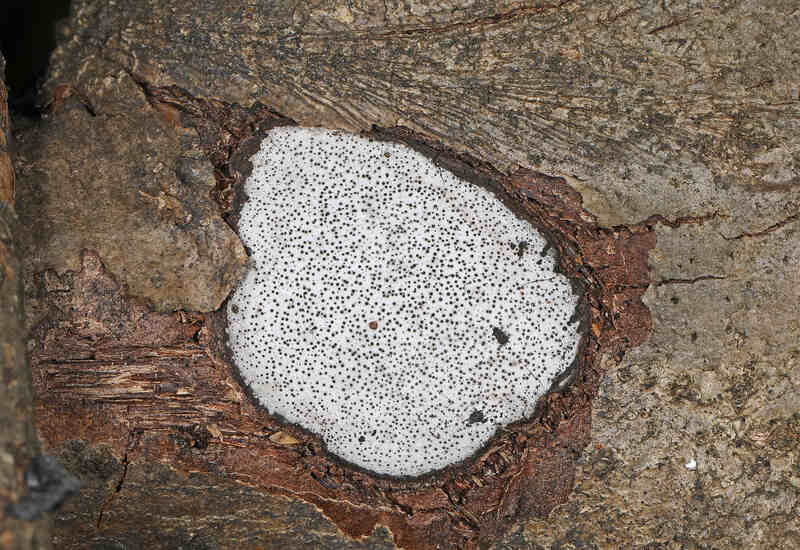

Pressured bushes usually host hypoxylon canker. The loss of life of branches and leaves at an oak’s crown offers the primary clue to this white-rot fungal illness. The wooden decays, inflicting lack of structural integrity.
Signs: If the stress isn’t resolved, the outer bark sloughs off, exhibiting tan to silver-grey to black fungal stromata (compact plenty of a fungus) on the trunks and branches. Dieback ultimately happens.
Causes: Lowered water uptake by pressured bushes, together with from drought and development injury, often causes some type of damage to the roots. Biscogniauxia atropunctata (previously Hypoxylon atropunctatum) then infects the tree.
Season: Hypoxylon canker usually happens in pressured oaks after a drought.
Threat Stage: Most species of oak are vulnerable however the black oak group extra so than the white.
Remedy: There is no such thing as a therapy, however eradicating broken branches will help gradual the development of hypoxylon canker. The tree will ultimately die. Elimination can stop the tree from turning into a hazard from wooden decay and should scale back unfold to different bushes.
Inonotus Root Rot
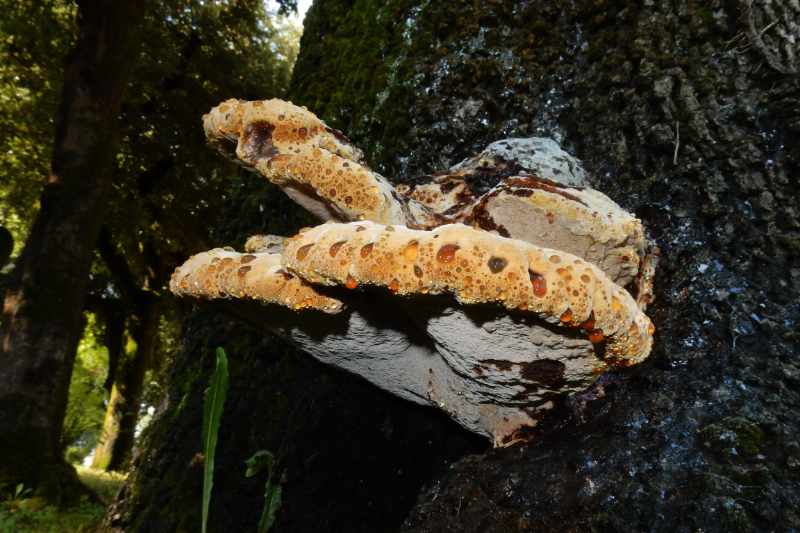

Department dieback takes place in inonotus root rot, the most typical wooden-rotting fungus. The oak tree has fewer leaves, that are often yellowed. Nevertheless, the tree might fall earlier than indicators grow to be evident. Inonotus root rot may additionally be referred to as oak bracket and weeping polypore.
Signs: Different indicators embrace very massive, gentle yellow to yellowish brown conks (mushrooms) on the base of the tree; the conks might “weep” a yellowish liquid. Previous conks flip black.
Causes: The fungus Inonotus dryadeus (previously Polyporus dryadeus) enters via wounds within the bark, together with pruning, garden mower, and weed-trimmer accidents.
Season: An infection happens at any time, and extreme injury turns into noticeable in summer season and early autumn.
Threat Stage: This illness is terminal.
Remedy: The one choice is to instantly take away the tree.
Laetiporus Root Rot
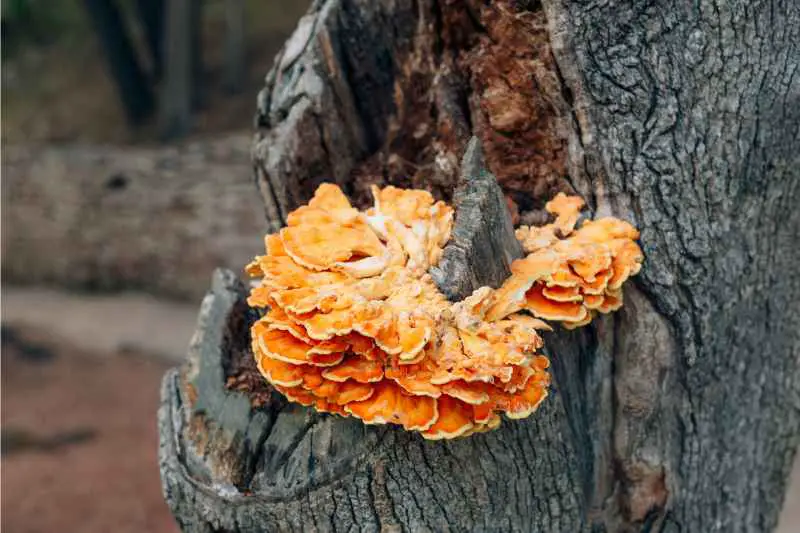

The looks of yellow to pinkish to orange, shelf-like conks herald extreme tree an infection in laetiporus root rot. The conks can vary in dimension from 2 inches to greater than 20.
Signs: Finally, the conks flip white with age. The bark the place these mushrooms kind turns into brown, brittle, and cracked. Some name these edible conks “chicken of the woods” as a result of they style like hen.
Causes: Accidents to different bushes enable Laetiporus sulphureus, now L. gilbertsonii, to invade the oak’s root system and assault the guts of the tree, decaying its wooden.
Season: Growths kind in summer season and autumn and fall off in winter.
Threat Stage: By the point fruiting buildings develop, vital injury is already performed, and the tree has grow to be vulnerable to wind injury and toppling.
Remedy: The tree ought to be eliminated on the first signal of laetiporus root rot to keep away from pricey bills comparable to roof restore.
Oak Leaf Blister
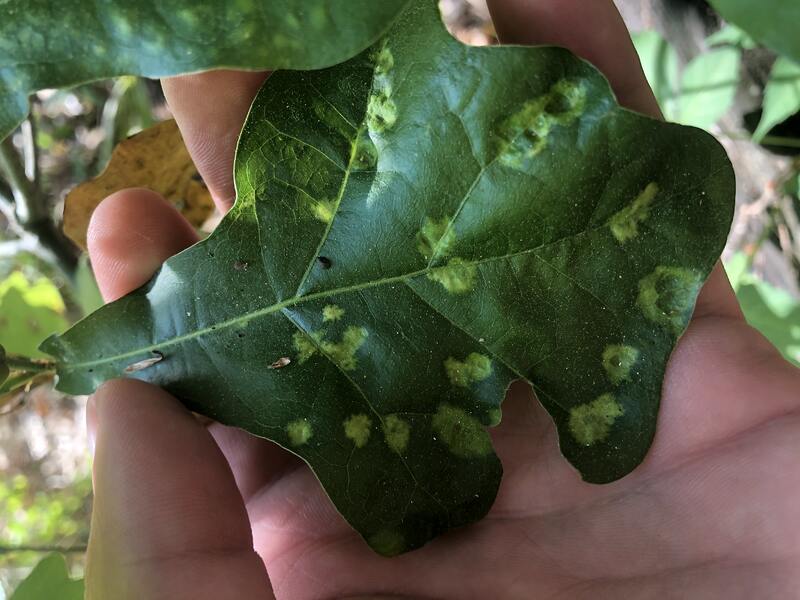

Spots up to 2 inches in diameter flip gentle inexperienced because the leaf with oak leaf blister grows; the spots ultimately grow to be brown. The leaves can bulge, grow to be depressed, cup, and twist.
Signs: Blisters elevate within the middle of the spots. When it has too many spots, a leaf can fall off the tree.
Causes: Secretions from Taphrina caerulescens lead to overgrowth of leaf tissue, inflicting the blisters.
Season: The illness tends to happen throughout particularly damp spring seasons. Solely minor an infection happens if the circumstances are unfavorable for the pathogen.
Threat Stage: Crimson oaks are essentially the most vulnerable. Leaves grow to be resistant to an infection the older they’re.
Remedy: Any fallen leaves ought to be raked and discarded to assist stop an infection the next 12 months. An ugly illness, oak leaf blister requires no therapy, though an applicable oak tree fungicide therapy may be sprayed as a protectant earlier than buds seem in small bushes.
Oak Wilt
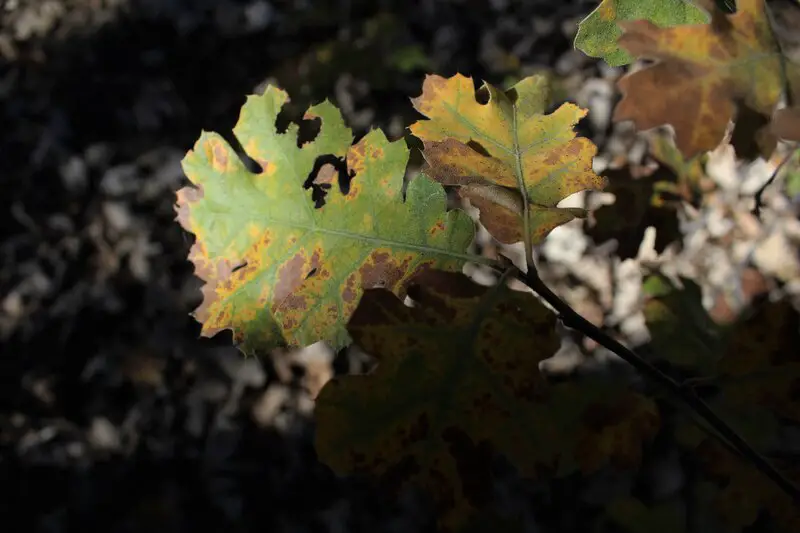

The pathogen inflicting oak wilt blocks water and vitamins from shifting correctly all through the vascular system (water-bearing tissue) of the tree. It causes leaf drop and loss of life.
Signs: Leaves on the crown of pink oaks flip pink-brown or bronze across the edges; there’s a sharp line between the bronze and inexperienced. Injury progresses downward via the tree. In depth leaf drop happens by late summer season.
Fungal mats develop and should trigger the bark to fall off. Brown or black discoloration can develop within the outer sapwood, the world of tree simply contained in the bark.
Causes: Sap beetles introduce the oak wilt fungus Bretziella fagacearum (previously Ceratocystis fagacearum) into tree wounds or via root grafts.
Season: Oak wilt illness seems in spring and early summer season, however bushes are extra susceptible throughout spring.
Threat Stage: Red oaks are most vulnerable and infrequently die inside a couple of months after signs seem. White oaks are considerably resistant and should take years to die.
Remedy: All bushes with oak wilt die. The illness rapidly spreads to close by oaks. Take away contaminated bushes swiftly and inject neighboring oaks with the systemic fungicide propiconazole to inhibit unfold. It’s also possible to dig trenches between bushes to assist stop unfold, which occurs rapidly.
Powdery Mildew


The illness powdery mildew invades canopies with poor air circulation and younger foliage in cool, moist shade. Foliage might flip yellow, curl, and drop early. Powdery mildew is a standard tree fungus in oaks and lots of different bushes.
Signs: This white fungus on oak bushes seems to be like child powder. It develops on each the highest and backside surfaces of the oak’s younger leaves. Tiny black or orange, pepper-like spots might seem.
Causes: Created by fungi (a number of species), spores distribute to younger leaves by way of wind and rain after using out the winter in buildings on fallen leaves.
Season: Spring and autumn, which have cooler temperatures, present circumstances for this illness to thrive. The fungi favor humid circumstances when nights are cool and days are heat.
Threat Stage: Probably the most susceptible tree is the pedunculate oak (Quercus robur), however younger oaks are additionally vulnerable.
Remedy: Powdery mildew causes no vital injury as a result of it seems late within the rising season; due to this fact, it requires no therapy. Whether it is particularly dangerous, a fungicide may be utilized when the tree is dormant. Take away fallen leaves, which might unfold the pathogen, and prune within the winter to present air and light-weight circulation within the cover.
Sudden Oak Loss of life
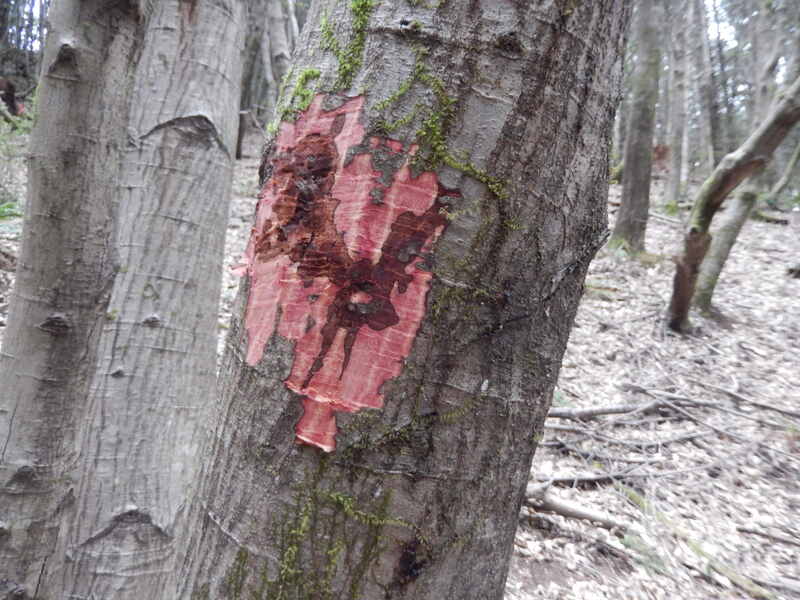

The outbreak of sudden oak death started on the West Coast and has been confirmed in different states. Its pathogen, Phytophthora ramorum, likes cool, moist areas.
Signs: Bleeding cankers within the decrease 10 toes of the trunk are sometimes the primary seen symptom. These cankers seep reddish-brown to tar-black, viscous liquid. After bleeding begins, coloration adjustments quickly from inexperienced to yellow or yellow-white after which brown.
Causes: The water mildew Phytophthora ramorum spreads by way of rain and wind from and to oaks by way of contaminated vegetation, comparable to rhododendron, lilac, and different shrubs, from nurseries and different shops.
Season: The pathogen turns into energetic within the spring. Cankers might encompass the tree trunk and kill the oak. Bugs (beetles) and different plant ailments might reap the benefits of the illness and hasten tree loss of life.
Threat Stage: Vulnerable species embrace pink oaks.
Remedy: There is no such thing as a treatment. Some oaks die inside a 12 months. Others might survive numerous years after bleeding cankers seem. The tree, and another vegetation with sudden oak loss of life, ought to be uprooted and destroyed.
Tubakia (Actinopelte) Leaf Spot
New or pressured bushes appear to be on the most danger of tubakia leaf spot, which is often known as “actinopelte leaf spot.” Extreme infections trigger untimely leaf drop and twig cankers.
Signs: Round, darkish to reddish-brown spots seem on the leaves, totally on the pink oak. Every spot may be ¼ to ½ inch in diameter, and spots can ultimately run collectively, creating blotches. A yellow halo surrounds every spot.
Causes: Moist climate will increase the vigor of this complicated fungus (Tubakia dryina [formerly Actinopelte dryina]).
Season: The illness can survive winter in contaminated twigs and leaves that don’t drop, with indicators rising after bud break. Signs are most prevalent within the late summer season and early fall.
Threat Stage: Crimson oaks are extra susceptible than different oaks, as are younger and pressured bushes. Verify what stress elements are affecting the tree and resolve them. The most typical stressor is iron deficiency.
Remedy: Rake and destroy all contaminated leaves to gradual the unfold of actinopelte leaf spot, which happens with wind and rain splash. Spraying with a fungicide could also be indicated for small bushes which have misplaced their foliage a number of years in a row.
Efficacious methods for treating diseases of oak trees
Magnificent and recognizable, oak trees provide any area shade, beauty, and a hint of the past. They are, nonetheless, vulnerable to illnesses that might jeopardize their long-term health, just like any other living thing. Fortunately, there are efficient treatment choices available to fight these prevalent illnesses and save your priceless oak tree.
A fungal infection known as oak wilt causes the tree’s water-conducting system to malfunction, resulting in wilting, discolored leaves, and eventually, death. This is one of the most prevalent diseases affecting oak trees. It is important to act promptly in order to treat oak wilt successfully. To stop the disease from spreading, a trained arborist might use methods like trenching and injecting fungicides to safeguard the tree’s vascular system.
Powdery mildew, which causes a white, powdery material on the leaves of oak trees, is another common disease. This fungal infection has the potential to weaken and stunt the tree’s development. The use of fungicides designed particularly to battle powdery mildew is one treatment strategy, along with routine trimming and observation to enhance air circulation.
An other disease that affects oak trees that results in browning and withering leaves is bacterial leaf scorch. Controlling this bacterial infection might be difficult since it spreads via insects. However, there are ways to control the illness and restrict its progression, such as by removing diseased branches or injecting medicines into the trunk.
Prevention is essential when it comes to protecting your oak tree from illnesses. It is possible to drastically lower the chance of disease development by maintaining general tree health with regular watering, suitable fertilizer, and sensible pruning techniques. Furthermore, it is important to act quickly to address any illness or distress indications by speaking with a qualified arborist. This will assist stop any damage and improve the likelihood of a full recovery.
Keep in mind that each oak tree is different and that diseases may range in severity. For an accurate diagnosis of the illness and recommendations on the best course of action unique to your oak tree’s requirements, it is imperative that you speak with a licensed arborist or tree care expert. You can ensure that your oak tree remains healthy and magnificent for many years to come by being proactive and making appropriate treatment investments.
Integrated pest control strategies to save oak trees
The use of integrated pest management (IPM) strategies is essential to safeguarding your oak tree from prevalent illnesses. IPM adopts a comprehensive strategy that incorporates a variety of tactics to control pests and diseases while reducing the effect on the environment, as opposed to depending only on chemical pesticides.
Healthy oak tree monitoring is a crucial component of integrated pest management (IPM). Pay special attention to any indications of pests or illnesses, such as unusual coloring of the leaves, wilting, or the presence of insects. In order to stop the spread of illness and guarantee timely treatment, early diagnosis is essential.
Encouraging and preserving a healthy environment surrounding your oak tree is another essential IPM strategy. Planting companion plants that attract beneficial insects and creatures is one way to increase biodiversity. Without the need for chemical treatments, these naturally occurring predators may aid in pest management.
In IPM, maintaining good cleanliness is also essential. Clear the area surrounding the oak tree’s base of any fallen leaves, rotting wood, or other debris since they might be home to pests and diseases-causing pathogens. Pruning sick or dead branches on a regular basis will stop diseases from spreading.
Targeted treatments could be required in situations when insect or disease infestations are substantial. But as a first line of defense, IPM stresses the adoption of eco-friendly techniques like organic sprays or biopesticides. These substitutes provide less of a threat to birds, beneficial insects, and the environment as a whole.
Finally, for efficient IPM, continuing education and keeping abreast of the most recent findings and developments on oak tree diseases and pests are essential. You may take proactive steps to avoid problems from occurring and react correctly in the event that they do by being aware of the unique hazards that your oak tree may encounter.
You may minimize the use of hazardous pesticides, preserve your oak tree from common diseases, and maintain the general health and harmony of your garden or landscape by using integrated pest control approaches.
Keeping your oak tree in a healthy environment
Keeping your oak tree’s habitat healthy is essential to avoiding and treating common ailments. Establishing appropriate soil conditions is the first stage. Well-drained soil with a pH of 6.0 to 7.5 is ideal for oak trees. Your oak tree will thrive in a more suitable environment if you evaluate the soil often and provide the appropriate additives.
Watering trees properly is also crucial to their health. While underwatering might stress the tree and increase its susceptibility to infections, overwatering can cause root rot and other fungal diseases. It is crucial to water thoroughly and sparingly, letting the soil gradually dry out in between applications. Mulching the area surrounding the tree’s base may assist control soil temperature and moisture retention.
Another essential component of keeping your oak tree healthy is regular trimming. Pruning includes eliminating unhealthy or dead branches, enhancing airflow, and preserving a canopy structure that is balanced. This increases the tree’s overall vitality and improves its visual appeal while lowering the chance of disease spread.
Preventing the spread of infections requires the implementation of appropriate sanitation techniques. By clearing away fallen leaves, twigs, and other debris from the tree’s surroundings, you lower the chance of infection and stop pathogen buildup. Furthermore, it is possible to stop the spread of disease to other trees by properly disposing of sick plant waste.
A healthy oak tree may also be a result of encouraging biodiversity in your environment. Beneficial insects and birds drawn to companion plants may aid in the management of pests that might endanger the tree. Furthermore advised is avoiding the use of dangerous pesticides and herbicides, since they may kill trees and disturb the ecology.
You may considerably lower the danger of common illnesses and guarantee your oak tree’s durability and beauty for many years to come by heeding these guidelines and keeping it in a healthy environment.

FAQ
How Do I Know if my Oak Tree is Wholesome?
Do the scratch take a look at. Inexperienced tissue lives beneath a wholesome oak tree’s bark. Nevertheless, if this tissue is brown or yellow, the tree might be dying. Watch out performing this take a look at; wounds in an oak may be invites to illness.
In addition to Illness, What Can Have an effect on How My Oaks Seem?
Oak galls are irregular, often rounded growths on the leaves, twigs, and branches; they arrive in lots of sizes. Fusiform rust is a pine illness that spreads from pine to oak again to pine once more; yellow to black spots seem on the leaves.
Sooty mildew grows on honeydew, a sticky liquid excreted by plant-sucking bugs; darkish mildew covers leaves and limbs. Oak borers tunnel below the bark. And defoliators comparable to caterpillars, sponge moths, cankerworms, and Japanese beetles can eat your leaves.
What Makes Oaks Vulnerable to Illness?
A pressured tree is extra liable to “catch” a illness. Many occasions, illness enters via wounds brought on by development, pruning, bugs, garden mowers, and weed trimmers. Drought and an excessive amount of moisture can entice molds and micro organism.
